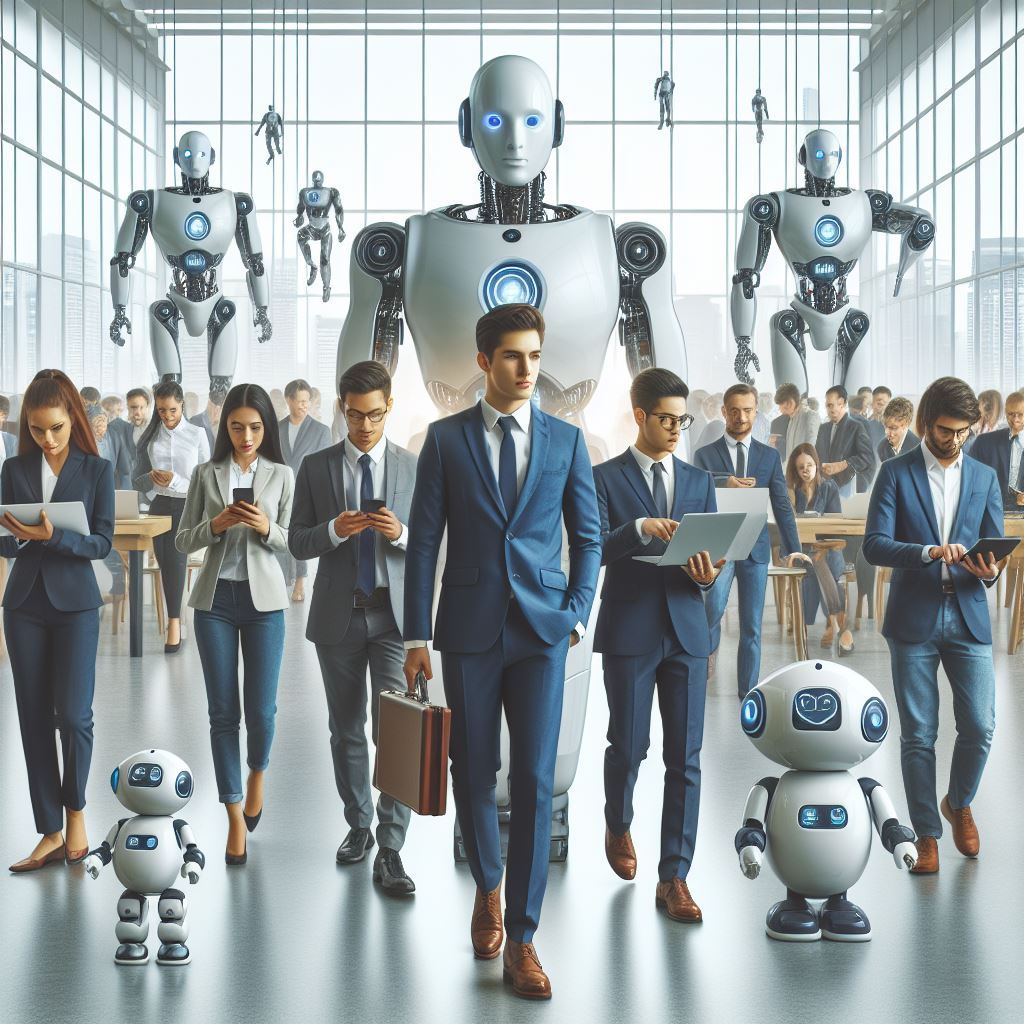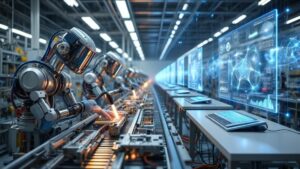How to Measure the Impact of AI on Businesses and Society
Picture a world where machines learn, adapt, and play a pivotal role in how businesses operate and our day-to-day lives unfold. Well, that world is here, thanks to AI stepping out of sci-fi realms and into practical use. Companies are tapping into AI to rev up their operations, make smarter decisions, and stay on the cutting edge. The impact is real, but to make the most of it, businesses need to understand and measure how AI is shaping their success, influencing strategies, and fostering sustainable growth.
In this exploration, we’ll not only unravel the ways AI is shaking up the business landscape but also share insights on how to measure and understand its impact.
The Transformative Power of AI in Business
According to a recent Forbes Advisor survey, a whopping 64% of businesses believe that AI is the key to boosting their overall productivity. This reflects a growing confidence in AI’s potential to transform how businesses operate. In this section, we’ll explore five ways businesses are making the most of AI:
Operational Efficiency and Automation
AI is revolutionizing business operations by automating repetitive tasks and processes. Machine learning algorithms enable businesses to streamline workflows, reducing manual effort and the risk of errors. From data entry to complex decision-making processes, AI-driven automation enhances efficiency, allowing employees to focus on more strategic and creative aspects of their roles.
Data-Driven Decision Making
One of the profound impacts of AI is its ability to analyze vast amounts of data swiftly. AI algorithms can sift through big data sets, identify patterns, and extract valuable insights. This empowers businesses to make data-driven decisions, improving accuracy and reducing reliance on intuition. From predicting market trends to optimizing supply chains, AI transforms decision-making processes.
Enhanced Customer Experiences
AI is reshaping how businesses interact with customers. Through chatbots and virtual assistants, companies can provide instant and personalized support, improving customer satisfaction. AI-driven recommendation systems analyze user behavior, offering personalized product suggestions, thereby enhancing the overall customer experience and fostering brand loyalty.
Predictive Analytics for Business Strategy
AI equips businesses with predictive analytics tools that forecast future trends based on historical data. This foresight aids in strategic planning, helping organizations anticipate market shifts, customer preferences, and potential challenges. Businesses can proactively adjust their strategies, staying ahead of the competition and mitigating risks.
Cost Reduction and Resource Optimization
By automating tasks, minimizing errors, and improving efficiency, AI contributes significantly to cost reduction. Predictive maintenance powered by AI can optimize resource usage by identifying equipment issues before they become critical. This not only reduces downtime but also extends the lifespan of assets, ultimately leading to substantial cost savings for businesses.
Metrics and Methodologies for Measuring AI Impact on Businesses
As businesses increasingly integrate artificial intelligence (AI) into their operations, the need to measure the impact of these technologies becomes paramount. To gauge the effectiveness of AI implementation, organizations rely on a range of metrics and methodologies. Let’s explore some key approaches and actionable insights for measuring AI impact:
Financial Metrics: ROI and Cost Savings
ROI (Return on Investment): Calculate the return on investment by comparing the gains from AI implementation against the costs. This involves assessing increased revenue, reduced expenses, and any additional profits attributed to AI.
Cost Savings: Quantify the direct cost savings achieved through AI-driven automation. Evaluate reductions in labor costs, operational expenses, and potential resource optimization.
Operational Metrics: Efficiency and Speed
Process Efficiency: Measure the efficiency of AI-optimized processes by comparing pre and post-implementation metrics. Look for reductions in task completion time, error rates, and overall resource utilization.
Speed of Decision-Making: Assess the speed at which AI facilitates decision-making processes. This involves evaluating the time taken to analyze data, generate insights, and implement decisions compared to non-AI scenarios.
User Satisfaction and Experience
User Feedback and Surveys: Gather user feedback to measure satisfaction with AI-driven services or products. Implement surveys to understand user perceptions, preferences, and areas for improvement.
User Engagement Metrics: Analyze user engagement metrics, such as interaction frequency and time spent, to assess how well AI applications resonate with users.
Societal Perception and Acceptance
Public Perception Surveys: Conduct surveys to understand how the public perceives AI implementations. Assess attitudes, concerns, and expectations to ensure alignment with societal values.
Ethical Impact Assessments: Implement ethical impact assessments to gauge the ethical implications of AI usage. This involves identifying and addressing potential biases, privacy concerns, and societal impact.
Predictive Analytics for Business Strategy
Market Trends and Forecasting: Utilize AI-powered predictive analytics to forecast market trends, customer behavior, and industry shifts. Measure the accuracy of predictions against actual outcomes.
Risk Mitigation: Assess the ability of AI to identify and mitigate risks in business strategies. Evaluate the effectiveness of AI in predicting and preventing potential issues.
How is AI Impacting Our Society?
In the world around us, AI is bringing about positive changes that touch our lives in various ways. This part of our discussion explores how AI is making a real difference in society. It’s not just about technology; it’s about how AI is improving healthcare, making cities smarter, and helping everyone, including those with diverse abilities, to lead more inclusive lives.
Advancements in Healthcare
Artificial Intelligence is fundamentally reshaping healthcare, introducing personalized approaches that significantly improve patient outcomes. The analysis of vast datasets enables AI to craft tailored treatment plans based on individual genetic profiles, medical histories, and lifestyle factors. This precision in healthcare not only enhances treatment efficacy but also minimizes side effects, marking a revolutionary shift towards more patient-centric care. Additionally, AI’s proficiency in interpreting medical imaging, such as X-rays and MRIs, plays a crucial role in early disease detection. By swiftly identifying anomalies, AI aids healthcare professionals in initiating interventions at earlier stages, leading to improved prognoses and reduced healthcare costs.
Education and Learning
In the realm of education, AI is fostering personalized learning experiences that cater to the unique needs of each student. Adaptive learning platforms, powered by AI algorithms, analyze individual learning patterns and adapt the coursework to align with students’ strengths and weaknesses. This not only optimizes comprehension but also encourages a more engaged and customized educational journey. Additionally, AI is addressing language barriers, making education more inclusive and accessible. Translation services powered by AI facilitate communication for students from diverse linguistic backgrounds, breaking down barriers to learning and fostering a more globally connected educational environment.
Environmental Conservation
AI is at the forefront of revolutionizing agriculture through precision farming practices. By analyzing intricate data sets encompassing weather patterns, soil quality, and crop health, AI equips farmers with insights to make well-informed decisions. This precision not only enhances crop yield and quality but also minimizes the environmental impact of farming activities. Through optimized resource utilization and sustainable practices, precision agriculture contributes to the preservation of ecosystems and promotes environmentally conscious farming.
Enhanced Accessibility
AI-driven assistive technologies are breaking barriers and enhancing accessibility for individuals with disabilities. Voice recognition, text-to-speech, and image recognition technologies empower people with diverse abilities, fostering inclusivity in various aspects of life. From facilitating communication to providing greater independence, AI-driven assistive technologies contribute to a more equitable and accessible society.
Ways to Measure the Societal Impact of AI
Public Perception Surveys
Conducting comprehensive surveys to gauge public perceptions of AI provides valuable insights into societal attitudes. These surveys can explore trust levels, concerns, and expectations, shedding light on how different demographics view the integration of AI into various aspects of daily life. Continuous feedback through surveys helps in tailoring AI implementations to align with societal values and expectations.
Ethical Impact Assessments
Implementing ethical impact assessments allows organizations to systematically evaluate the ethical implications of AI applications. This involves identifying potential biases, ensuring data privacy, and assessing the overall ethical considerations associated with AI systems. These assessments contribute to building transparent and accountable AI systems that prioritize ethical standards and align with societal norms.
Inclusivity and Accessibility Metrics
Measuring the inclusivity and accessibility of AI technologies is crucial for ensuring that advancements benefit diverse populations. Metrics can include the accessibility features integrated into AI applications, such as voice commands or screen readers, to assess their effectiveness in catering to individuals with diverse abilities. Evaluating inclusivity metrics helps in creating AI solutions that are accessible and beneficial for all segments of society.
Impact on Employment Dynamics
Assessing the impact of AI on employment is a key metric for understanding societal implications. This involves tracking changes in the job market, identifying sectors experiencing job growth or decline due to automation, and evaluating the need for retraining and upskilling programs. Understanding the evolving employment landscape helps in developing strategies to mitigate potential negative consequences and harness the positive aspects of AI for job creation.
Analysis of Social Well-being Indicators
Examining social well-being indicators, such as quality of life, community engagement, and overall satisfaction, helps in gauging the holistic impact of AI on society. By assessing how AI influences these indicators, organizations can ensure that technological advancements contribute positively to societal well-being. This approach involves considering factors beyond economic metrics, providing a comprehensive view of AI’s influence on the overall welfare of communities.
Wrapping Up
In wrapping up our journey through measuring the impact of AI on businesses and society, it’s clear that AI is not just a set of numbers but a powerful force shaping our world. Beyond the financial gains and operational efficiencies, AI touches the essence of our communities and daily lives. As we’ve explored the metrics, from dollars saved to public perceptions, it’s evident that the influence of AI is richer and more nuanced than we might initially think.
Looking ahead, the impact of AI is a story in progress, one that prompts us to consider not only how it changes businesses but also how it molds our societies.
Ready to supercharge your business with the potential of AI? Take the leap into a future of innovation and efficiency with RTS Labs’ AI consulting services.






